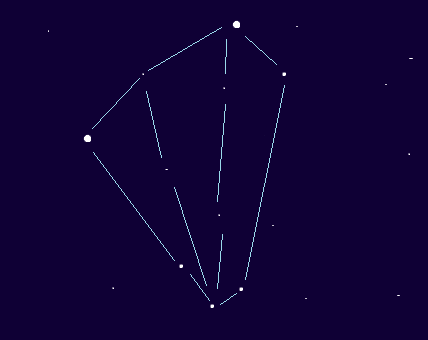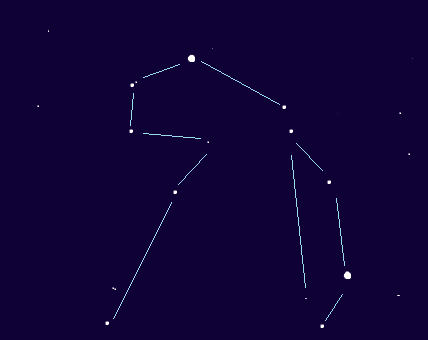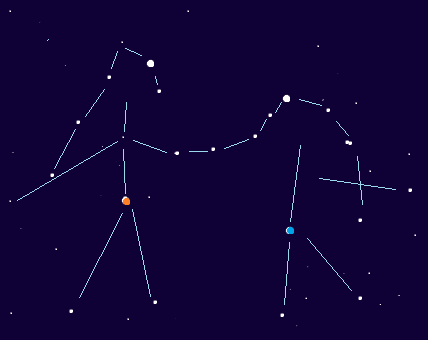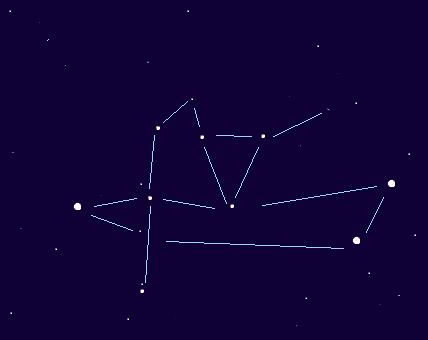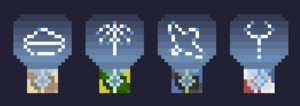Skrell Faith: Difference between revisions
| Line 119: | Line 119: | ||
== Weishii == | == Weishii == | ||
A relatively "newer" belief within the Jargon Federation; Weishii is a schism of Qeblak that flourished during the first colonial expansion of the | A relatively "newer" belief within the Jargon Federation; Weishii is a schism of Qeblak that flourished during the first colonial expansion of the Skrell species. Weishii follows a similar belief to that of Qeblak - with slight distinctions. Those of the faith believe that there is a more spiritual path that can be travelled in order to gain insight into the galaxy, mostly revolving around the various constellations spotted from the Homeworld. The constellations are observed and then meditated upon for further understanding of oneself. | ||
There are a variety of techniques | There are a variety of techniques for those who follow Weishii that can be utilized in order to gain this deeper upstanding. Meditation, the reading of multiple sacred texts united within a book known as the Ron'tor-Aq, and the use of special brews created with wulumunusha extract being the most common. It is encouraged by those of the faith to combine these techniques in order to better the chances of discovering a deeper understanding of themselves and the galaxy they find themselves within. | ||
Weishii relies on natural groves, grottos, and other secluded areas to provide suitable sanctuaries to practice the faith. This reliance on nature has resulted in it playing an important role in the Weishiin faith; followers are more likely to have an appreciation for nature, while the more ardent followers will practice vegetarianism or veganism. Weishiin Skrell as a whole do not put as much emphasis on academia when compared to those who follow Qeblak, although they are still subjected to the same cultural expectations of the Jargon Federation. | |||
=== Weishiin Sanctuaries === | === Weishiin Sanctuaries === | ||
Revision as of 17:50, 31 July 2022
| Skrell Lore Pages | ||
|---|---|---|
| Skrell | Skrell Biology · Skrell Relationships · Notable Skrell | |
| Planets, Systems, Settlements | Qerrbalak · Qerr'Malic · Aliose · Aweiji · Tattuqig · Xrim · Diulszi · Skrell Abroad · Notable Skrell Systems and Locations · Generation Fleets · The Prescient Republic of the Qar | |
| Organizations, Factions, Politics | Nralakk Federation · Skrell Politics · Skrell Enforcement · Federation Crime and Resistance · C'thur in the Federation · Dionae in the Federation | |
| Culture, Society, History | Skrell Culture · Skrell Cinema and Idols · Skrell Education · Skrell Technology · Skrell Cuisine · Skrell History · Skrell Beliefs · Skrell Mythology | |
Skrell Faith
The Skrell have largely followed the core tenants of Qeblak, with some minor schisms occurring throughout the ages. An overlapping theme across these religions is the reverence of the stars that represent the various cosmic entities in which the Skrell recognise. Whilst most other species eventually outgrew this early form of religion, the Skrell have managed to maintain for millennia.
Qeblak
Qeblak is considered the oldest faith by the Skrell. It is a mixture of both astrology and astronomy, the doctrines of the faith revolving around both giving divinity to astronomical objects, while also studying them in great detail. The central theme of the religion has since bled into Skrellian culture, and has resulted in those that follow the Qeblak being highly celebrative of the pursuit of knowledge, exploration, science and innovation.
Followers of Qeblak believe that through intricate calculations, it is possible to predict terrestrial events from celestial observations. It is believed that Qeblak has its roots in the calendrical system known as the Nral'oqq, which was used to predict seasonal shifts. It would eventually evolve into the first rudimentary faith after it was believed that these celestial changes were in fact a method of divine communication provided by the cosmos surrounding them.
As Qeblak relies on astronomy and other sciences to practice the faith, it is seen as the more academic Skrellian religion. Those who practice Qeblak are more likely to emphasise the importance of knowledge and learning when compared to Weishiin Skrell. Qeblak is also seen as the religion most favoured by the Jargon Federation by its critics; its centralised hierarchy and established orthodox doctrine allow greater control, making it an effective tool to ensure its followers are loyal to the Federation. The Jargon Federation officially makes no distinction between Qeblak and Weishii, treating both as equally sanctioned religions within Federation space.
Observatory Domes
Members of the Qeblak faith come together on a biweekly basis at their local Observatory Dome, a building that acts as both a church and a place of astronomical study. The Jargon Federation does its best to ensure that at least one Observatory Dome is within a reasonable distance per thousand Qeblak followers, and that everyone has reasonable access to its facilities.
Starkeepers are the hosts of these Domes, more senior members of the Qeblak faith who are tasked with the maintenance of the building, while also being in charge of organising events where members of the community can practice the faith. The more common events involve lectures on a given galactic entity such as stars, planets, or nebulae, which are showcased using holographic projectors to allow attendees to see and experience what is being covered. Non-Skrell who attend these events describe it as an ethereal experience.
Outside of the Federation, Observatory Domes can vary in terms of quality and ease of access. In Tau Ceti in particular, the Starlight Zone in Mendell City is the only location with established observatory domes, with most being located in the Lekan District. These domes are not as spectacular as those found in the Federation, with only a handful having access to the holographic projection equipment necessary to provide a similar experience as Domes in the Federation. There are also a few Observatory Domes located within Severson City, and are more unique in that they are built upon mobile barges that go out to sea for their biweekly events. These barges are quite small, however, meaning that many Qeblak followers within Severson are forced to cross into the Lekan District to practice their faith, much to their annoyance.
Leadership
Qeblak is governed by only particular Skrell, those demonstrating extraordinary psionic prowess. It is believed that only the most powerful of psionics are capable of accurately gleaning information from astronomical objects, and translating the information received from them. The clergy, known as the "Qyu-Nyala", is composed of different ranks depicting how far a Skrell is on their journey as religious leaders.
Qe'Puu - Starsquires
The Qe'Puu are the youngest, usually around the ages of 20 - 30 years old. They are typically Skrell with high psionic potential that have chosen to devote their lives to Qeblak, and will undergo apprenticeships to observe and learn from those that have come before them. They will remain as Qe'Pluu until they successfully pass a series of tests - both in knowledge and psionics. They usually tasked with menial labour, such as organizing a higher-ranking member's astrological charts or cleaning the places of religious worship - a massive temple that has a glass ceiling to enable transparent viewing of the sky above known as "The Observatory Domes".
Qe'Naho - Starkeepers
The Qe'Naho are above the Qe'Puu, and are described as the 'protectors of Qeblak'. The Qe'Naho are seen as the next generation of Skrell that will lead the religion and as such are expected to ensure the protection of the faith through rigorous studying of the doctrines, and uphold it at all times. Qe'Naho can only ascend the ranks of Qeblak if a higher-ranking member retires, which shifts the hierarchal system that guides the faith. Starkeepers act as counsellors, advisors and community spiritual leaders.
Qe'Bqak - Starchanters
The Qe'Bqak are the highest-ranking members of Qeblak, and are considered masterful psionic wielders. They study astronomical objects, transcribing them into Lu-Qsi (Abyss Journals). Skrell that receive this position are expected to retire once they believe they have completed their work, with the culture of the Skrell usually resulting in them retaining the position until their death. Qe'Bqak are the only members of the clergy allowed to give advice to the Grand Councillor.
Qe'Kasho - Starseeker
The Starseeker is a role of authority within the Qeblak faith, with the main responsibility of managing and organising the clergy. It has no authority outside of matters related to Qeblak, and while superior to Starchanters within the faiths internal structure, the Starseeker is unable to provide advice to the Grand Council in any official capacity. Becoming a Starseeker can only be attained through assignment by Starchanters through a divination ceremony, performed soon after the death of the last Starseeker. The ceremony itself requires five of the most senior Starchanters to come together at the Qeblak'i archive, who will discern who will be the next Starseeker based on their findings.
There are no official requirements to being a Starseeker other than being a fully grown adult (by Skrellian standards), and to be a member of the Qeblak faith, but all recorded Starseekers have so far been Skrell of high psionic aptitude and are typically primary numericals within Federation society.
Holy Prayers of Qeblak
Miasmic Cluster (Gaqq-qu'ya)
From the path one fell, where their duty lay neglected, there is only forgiveness to ask, of the cosmos that has yet to be traversed, allow one time to re-ascertain their goals, and return to the path aligned for them.
Beginning of the Protostar (Wetl'qu-Qih)
The humble beginnings of all, the start of a process anew, all that one asks is for the stars to align, and grant aid in the future to come, so that one can travel the path created, for it is only through obedience, can one strive for success.
Devourer of the Cosmos (Eqqa-Luyal)
Hallowed cosmos, custodian of life and death, the price has been paid, align the stars and guide, the souls of stardust, that have since left our world.
Star-Bright (Qu-qu'qu)
Shining bright amongst, the most blessed of stars, it is the cosmos one calls, to give it praise and admiration, its beauty ever-unfolding, its rage known, one can all but ask, for protection.
Marriage & Death
Marriage is considerably different for Skrell, as their relationships are typically not as monogamous as the other species found within the Orion Spur. Ancient followers of Qeblak created a ceremony for the joining of various Skrell, eventually calling it the "Pairing of the Stars" or "Quy-aqa", which has survived for thousands of years and evolved to what it is today. The ceremony is considered incredibly intimate, and a sign that the Skrell within the newly forming Quya respect the foundations of the union. The actual planning of the ceremony can take years, with minute details considered highly important to the result of the ceremony. Most will take place within the Observatory Domes, hosted by the same number of Starkeepers as there are Skrell willing to form a union.
The actual ceremony will commence just after sunrise, and is expected to occur throughout the whole day. Skrell from the Quya will select a Starkeeper, who will eventually be told about the respective Skrell's wishes and desires in regards to the formation of the Quya. After the process has concluded the various Skrell will be escorted to a circular altar, where they will each stand opposite of another and join hands. The Starkeepers will then circle around the union, each psionically expressing the knowledge given to them by those within the forming Quya. After this is done, the Skrell will psionically bond through the use of a process known as "mind-melding". This process is the final step in the ceremony, and is meant to symbolize the attachment to each Skrell within the Quya. Should they wish, the Quya will then be registered within the Jargon Federation.
Death is not considered the end by the Skrell; merely a temporary transition between what is here, and what is within the cosmos. Qeblak describes death as being an invitation to join the cosmos, whether as the smallest comet or the largest quasar, all Skrell are said to join those who have already departed. The most common method for post-mortem instructions is burial, so that the body can be reabsorbed back into the environment it stemmed from.
Doctrines
The Doctrines of Qeblak, or known as the Qrikiqi, is a set of virtues which constitute the major practices of Qeblak. They are:
- Waaq Qrikiqi: Studious (Nral'Malic: Wa'Pii)
Studying and the gaining of knowledge is a cornerstone of both Skrell culture and the Qeblak faith. In context, this virtue is the studying of the stars and constellations, and divining meaning from the viewers interpretations.
- Laqiq Qrikiqi: Obedience (Nral'Malic: Laqiq)
The virtue of obedience can be interpreted in many ways, but is normally recognised by practitioners as viewing and accepting the teachings of Starkeepers and Starchanters. Another interpretation commonly held is obeying the will of the universe.
- Qowii Qrikiqi: Tolerance (Nral'Malic: qo'Wiq)
Like obedience, tolerance can be interpreted in multiple ways. Most accept that its meant in a more general form, and that followers should show tolerance to those not of the Qeblak faith as well as non-Skrell. Alternatively, it can also be seen as tolerance for what the constellations say, and how sometimes you may not receive the interpretation you wanted.
- Vri'Wii Qrikiqi: Diligence (Nral'Malic: Vqiwii)
Diligence is one of the more straightforward doctrines of the faith. The proper study of the constellations must be made in order to receive the most accurate interpretation.
- Nlamo Qrikiqi: Patience (Nral'Malic: Nlaq'Wo)
Patience, like above, is a straightforward doctrine. Patience, diligence, and study are all needed in order to properly read the constellations, but patience is taught in particular as rushing to conclusions ultimately leads to false readings.
Weishii
A relatively "newer" belief within the Jargon Federation; Weishii is a schism of Qeblak that flourished during the first colonial expansion of the Skrell species. Weishii follows a similar belief to that of Qeblak - with slight distinctions. Those of the faith believe that there is a more spiritual path that can be travelled in order to gain insight into the galaxy, mostly revolving around the various constellations spotted from the Homeworld. The constellations are observed and then meditated upon for further understanding of oneself.
There are a variety of techniques for those who follow Weishii that can be utilized in order to gain this deeper upstanding. Meditation, the reading of multiple sacred texts united within a book known as the Ron'tor-Aq, and the use of special brews created with wulumunusha extract being the most common. It is encouraged by those of the faith to combine these techniques in order to better the chances of discovering a deeper understanding of themselves and the galaxy they find themselves within.
Weishii relies on natural groves, grottos, and other secluded areas to provide suitable sanctuaries to practice the faith. This reliance on nature has resulted in it playing an important role in the Weishiin faith; followers are more likely to have an appreciation for nature, while the more ardent followers will practice vegetarianism or veganism. Weishiin Skrell as a whole do not put as much emphasis on academia when compared to those who follow Qeblak, although they are still subjected to the same cultural expectations of the Jargon Federation.
Weishiin Sanctuaries
Weishiin Sanctuaries have little to no standardisation; many followers of the faith do not believe in consecrated buildings designated for their faith and instead utilise the wilderness as central meeting places for their religious events. These places usually form around natural groves and clearings in the woods, or around coral reefs in more shallow waters, preferably away from any sources of light or noise pollution.
Once these sanctuaries are formed and Weishii communities established, it is expected that those who are on their journey to become Masters of the faith will maintain and care for their local sanctuaries. Masters of the faith will typically tour these sanctuaries in their local area, sharing knowledge and providing services where needed. The act of touring is known as Kon’ra‘Qii, literally translated to ‘To move and talk’.
Because of the nature of the faith and how these sanctuaries develop, Weishii followers are not similarly affected by moving outside of the Federation as Qeblak followers are; wherever Weishiin communities develop, sanctuaries are soon to follow as long as there's wilderness for them to be established. Biesel in Tau Ceti has one of the largest concentrations of Skrell in the system, and as such multiple sanctuaries can be found around the planet, typically on the outskirts of the planets population centres. The Starlight Zone’s Severson City has an understanding with its neighbouring Lekan District, allowing Weishii followers from both neighbourhoods to use the district’s access to Severson’s Rift, which allows travel to Weishiin Sanctuaries that have formed in its shallows. There are also several land-based sanctuaries that can be found in the outskirts of Mendell City, towards the mountain ranges to its west.
Leadership
Weishii's hierarchy is based on age stratification; where the eldest, in terms of being a believer, are usually those that oversee the faith. The "clergy" is split into three categories, each being a distinct telling of how far a believer has progressed within Weishii. The entirety of the "clergy" is known as the "Weishiiq". It is a very decentralized hierarchy, with the eldest of the Weishiiq typically left to make their own minor choices in regards to a sanctuary and how to teach.
Wei'Qii - Apprentice
An apprentice is a young believer, who either has yet to learn about the faith or is in the beginning stages of their studies in regards to the faith. They are frequently assigned to journeymen in order to be mentored in regards to Weishii, mostly associated with the Ron'tor'Aq and the brewing of wulumunusha extract within various liquids - mostly Dyn tea.
Wei'Rii - Journeyman
A journeyman is an older believer within the Weishii faith, and has managed to successfully provide evidence of their teachings to a Master. They are considered to be the mentors of Weishii, and are obliged to tutor the fledgeling apprentices. They are typically well-versed in the teachings of the Ron'tor'Aq and are expected to obey the doctrines set forth by the holy text.
Wei'Vii - Master
The masters of Weishiiq have essentially passed through the chain from the lowly beginnings of an apprentice all through to the final stages of becoming a master; producing their own text that will be evaluated by the eldest of masters through the process of Kon'ra'Qii. Only upon the clearance of five grandmasters, will a journey be accepted to become a master. Masters are also obliged to begin their own sanctuaries and foster a community in which believers can thrive and learn.
Holy Scriptures of Weishii
"For when there existed both light and darkness, there existed the cosmos. The benevolent energy, shared across the all-covering galaxy that would, be embued within the Skrell. It is only through, the understanding of oneself that one can, truly begin to ascend spiritually."
"Defiance goes against the teachings, even in its simplicity. One cannot be defiant, and obedient to the teachings. It is only through obedience, can one achieve excellence."
"Meditation within solace will yield, greater results than that of meditation, within the spur of a cacophony. Remaining, serene, even after the process of meditation, is a vital aspect for all students of the faith. Intrapersonal conflict must be dealt with, for the teachings to be useful."
Marriage & Death
The views on marriage for Weishiin are very liberal. It is considered not as a religious duty, and Weishii does not compel a person to be married. It does not force somebody to remain as a bachelor. It is not laid down anywhere that followers must produce children or regulate the number of children that they produce. It allows each individual the freedom to decide for themself all the issues pertaining to marriage.
Despite the faith not considering it a religious duty, there are various traditions and customs that are expected to be followed by those that wish to form a Quya. The ceremony is considered incredibly private, with most being only witnessed by the Wei'Vii initiating the Quya. The process is rather intimate, as the Skrell will all drink from a singular chalice spiked with wulumunusha extract - where they will then meditate and form a "Nlom'akk" or a "Psionic Link". This is meant to emphasize that the Skrell are no longer individuals, but a Quya.
Weishii have similar beliefs to that of Qeblak in regards to death; it is merely a transitioning stage. Once a Skrell has passed, a small ceremony will be held within a sanctuary, where both the Quya and Clergy will sing various hymns. This meant to draw the spirit of the Skrell out of its body, before the final process of the funeral rites - cremation. If the hymns had not drawn the spirit out, the cleansing burn will force it out.
Doctrines
The Doctrines of Weishii, or known as the Wei'Priqi, is a set of virtues which constitute the major practices of Weishii. They are:
- Agrok Wei'Kriqi: Determination (Nral'Malic: Agro'Qi)
Determination is a key component to the Weishii faith. Determination to one’s self and one’s future but also determination to the faith and the community as a whole. This doctrine is focused on bettering the individual and those around them.
- Ziroq Wei'Kriqi: Serenity (Nral'Malic: Zi'ro-Qii)
Serenity ties directly into the core tenets and practices of Weishii. This doctrine is often associated with the many meditations and tea ceremonies that are held by the Weishii faith. Followers of Weishii are often encouraged to be peaceful and serene in any situation.
- Qanhe Wei'Kriqi: Honesty (Nral'Malic: Kan'Chiq)
Being honest is the way of the Weishii faith. Lying is frowned upon due to the impacts it can have on the community and the individual alike. For a community to arise and respect each other, everyone must be honest and forthcoming with their feelings and grievances.
- Qlonii Wei'Kriqi: Wisdom (Nral'Malic: Wronoqi)
Wisdom is highly regarded within the Weishii faith and it is said to be the hardest doctrine to fully understand. What wisdom means is ultimately up to the individual; however, those who consider themselves wise may be shocked to hear that others may not view them the same. This leads wisdom up to the interpretation of the individual, but also the community.
- Wra'Qos Wei'Kriqi: Acceptance (Nral'Malic: Qonros)
Acceptance is fairly straightforward. Those with an open, and friendly, mind will be accepted into the faith with no issue as long as their intentions are pure. Weishii is also accepting of those willing to change and align with the core tenets. Being welcoming to those of all backgrounds is extremely important to the followers of Weishii and the community around them. Those who participate in deductive behaviors within the Jargon Federation are said to be impure by the Weishii faith.
Shared Constellations
The constellations deemed important by both Qeblak and Weishii followers:
The Island
Meanings: Loneliness. Introspection. Earth. Rising above, or, in certain orientations, sinking beneath. Reality.
The Hatching Egg
Meanings: New beginnings. A fresh start. Youth. Life. Excitement. Ignorance. Foolishness. Joy.
The Star Chanter
Meanings: Wisdom. Spirituality. Connection with the stars. Connection to history. Aloofness. A rigid path. Air.
The Jiu’x’klua
Meanings: Art. Creation. Loss. Sadness. Longing. Communication. The imaginary.
The Stormcloud
Meanings: Conflict. Shock. Surprises. Tension. Endurance. Strength. Force. Fire.
The Gnarled Tree
Meanings: Age. Wisdom. Sickness. Frailty, or, in certain orientations, toughness. Rigidity. Tradition. Plantlife. Balance.
The Poet
Meanings: Communication. Progress. Science. Advancement. Longing. Art. Expression. Loneliness. Contentment. Dreams.
The Bloated Toad
Meanings: Greed. Arrogance. Wealth. Success. Smugness. Laziness. Accomplishment. Adulthood.
The Void
Meanings: Death. Endings. Mystery. The unknown. Fear. Danger. Creation.
The Qu’Poxiii
Meanings: Love. Friendship. Company. Opposites. Teamwork. Happiness. The material. Safety. Progress. Support.
The Fisher
Meanings: Hard work. Stagnation. Embarrassment. Water. Patience. A long, but productive wait.
Qwei’Paqui - Astrological Tarot Cards
Before the Skrell were able to reach other planets the Qwei’Paqui (Stargazing Cards) were rarely used; they were ideal for times when there were no stars in the sky to be observed, but typically the tarot was ignored for more traditional stargazing events. Post-Space Age, however, the Skrell have found more utility in having tarot cards on hand. As the Skrell move further and further away from Nralakk, it becomes impossible to see the main constellations that have reverence in Qeblak or Wesihii, making the Qwei’Paqui important for those who wish to stargaze away from home.
While not typically used by Skrell living in Nralakk, the Qwei’Paqui sees use by most Skrell in the Federation, with local decks including both the main Qeblak and Weishii constellations along with any local constellations that have been approved by the Qeblak church. The tarot also sees use outside of the Federation, with most Skrell communities such as Mictlan and New Gibson having their own local decks - the only exception to this being Europa, due to the colony being deep underwater.
Usage and How to Perform Readings
Readings are generally done using only the main constellations (those shared by Qeblak and Weishii) and the user's own minor constellations; cards with minor constellations that are not part of the user's home constellations are usually withdrawn from the deck, but can be kept depending on the deck owner’s attitude towards the minor constellations. For those who live in areas with no observable constellations, such as the Skrell on Europa, the Qwei’Paqui completely replaces stargazing. In these cases, only the main constellations shared by both Qeblak and Weishii are used.
Qwei’Paqui cards can either be normal facing or reversed facing; normal facing is associated with positive attributes, while reverse facing is associated with negative attributes. For constellations that have more neutral attributes, the connotations rely on how the card is drawn; the attribute ‘social standing’ associated with New Gibson’s Iqi Star could be seen as a loss or gain in social standing depending on the card’s facing, for example.
Card reading can also be used by those who are travelling, with the first instances of it being used this way dated to the Skrell Age of Sail; in the modern-day, those serving on Qukala vessels, trading ships, or otherwise travelling for long periods of time will use the Qwei’Paqui as a quick way of divining their fortune when being able to find constellations may prove difficult, or if stargazing would be too much of a distraction from more immediate concerns.
While stargazing is seen as a communal affair, the Qwei’Paqui is seen as more personal since the individual draws their own cards. Sharing any divinations made is still common and tarot readings can be done as a group, but any interpretations that can be made are regarded as a personal matter that should not be assisted with. The only exception to this are the Qeblak and Weishii priests, who are seen as better educated in divination than your average Skrell, and are generally relied on by followers to offer insight in the event that they are unsure on how to interpret their observations.
There are two types of readings that are common throughout Skrell society: Daily Readings and Bi-weekly readings. Daily readings became popular during Qerrbalak’s Age of Sail period; the violent weather patterns of the planet made travel by sea a dangerous affair up until modern sailing and weather prediction were innovated, which made regular tarot card readings popular for the more superstitious Skrell. Daily readings are performed by shuffling the deck and taking four cards, where one card acts as the centre, and the other three cards take place left, right, and above it. The centre card represents the main focal point of the matter, while the other three cards will describe the events surrounding it. Daily readings are only used on their own, and during times when stargazing would either be impossible or dangerous while travelling.
Bi-weekly readings were the first method developed to use the Qwei’Paqui, being used in conjunction with stargazing events or on their own if the skies did not allow for stargazing with the naked eye. These readings tell a story by linking past, present, and future events together; Three cards are drawn after shuffling the deck, and from left to right are meant to represent an event that happened or will happen in the user’s past, present, and future. Any divination made using the bi-weekly reading is seen as separate from any readings made while stargazing if both are used at the same time, but they can be tangentially related.
Outside of these readings, some Skrell are known to come up with their own way of divination through the Qwei’Paqui. This is typically done by Weishii followers due to the less dogmatic nature of the religion, while Qeblak followers tend to stay to the readings that are approved by the church.
Examples of Qwei'Paqui cards
Syncretism of Skrellian Beliefs
Due to the structure of both Qeblak and Weishii being more inclusive than most religions, the Skrell faiths have gained a small following of non-Skrell, most notably Humanity. The studying of stars and constellations from Qeblak, and the spiritual focus in the Weishii faith both appeal to those who follow nontheistic religions, such as Buddhism. This has also worked inversely, with some Skrell co-opting parts of Buddhist teachings that they believe compliment their own faith.
Other than the religious aspects, Skrellian practices have found a small following in human circles, such as astrologists; Constellations and their interpretations are used similarly to how they would be used in the Skrell faiths, but without associating divinity to them or any other religious connotations. This has had mixed reactions from Skrell, with most opinions ranging from dismissiveness to annoyance.
Requirements for Employment With Megacorporations
To ensure that the role of Chaplain aboard Megacorporation facilities is carried out by qualifying personnel, the Jargon Federation and Qeblak Starchanters have provided a list of requirements for those who wish to be employed as a priest. Potential applicants must:
- Hold the title of Starkeeper within the Qeblak faith.
- Be at least 120 years of age.
- Hold a degree in theological studies or a similar field, as well as a second degree related to astronomy.
- Have a minimum SCS of 6.7 for Federation citizens.
Due to the decentralised nature of Weishii, the Federation and notable Weishii followers have been unable to provide a clear list of requirements for Weishii priests. As such, the only requirement for an employed priest of the Weishii faith is that they are either currently a Journeyman or Master of the Weishii faith, and have received some form of formal education in theological studies.
Religious Holidays and Events
Coming of Age
Qeblak Ceremony
For Qeblak believers, this ceremony is more like a religious exam. The Skrell who is going through the ceremony will enter their local observatory with their Starkeeper. The Skrell must then recite the Wetl'qu-Qih, or 'Beginning of the Protostar'. Once this is done, they will have to go through a rigorous exam where their knowledge of the faith is tested, before finally being given a set of constellations to identify. After identifying the constellations they must state what each constellation means to them while their mind is being read by the Starkeeper. Once the ceremony is finished, the Starkeeper will divine a 'fortune' for the Skrell, giving them a glimpse of what their life will be like using the interpretations given earlier, as well as advice on how to ensure or alter this path. Afterwards, they are given a shoulder cape and greeted by their close friends and family as they celebrate.
Weishii Ceremony
For Weishii believers, the ceremony is a lot more relaxed, with an emphasis made on the person's spiritual readiness to become an adult, rather than testing. The ritual is hosted normally by a Wei'Vii, a Master of the faith, and is more communal than the Qeblak ritual. The Skrell going through the rite will imbibe a special tonic made from wulumunusha extract while engaging in a spiritual discussion telepathically with the Master. Observers will then look on and chant; producing a low melancholy of warbling and croaking. The purpose of the discussion is for the Master to gauge the Skrell’s understanding of themselves and the cosmos. Using this information, the Master will give them parting advice at the end of the ceremony for them to reflect upon, with the aim of improving themselves as a person.
Bright Nights
Bright Nights is a term used for two times of the year where the constellations important to the Qeblak and Weishii faiths are most visible on Qerrbalak; this is due to the orbit and rotation of the planet showcasing the optimal view of the constellations. In the summer, the constellations Hatching Egg, Jiu’x’Kula, Gnarled Tree, Poet, Qu’Poxii, and Fisher can be seen. In the winter, the constellations observed consist of The Island, Star Chanter, Stormcloud, Bloated Toad, and Void are most visible.
Now that the Federation has expanded outside of the homeworld, Bright Nights have evolved into a religious ceremony where observers gather inside their local observatory and stargaze; often looking for their planet’s constellations. This is normally accompanied by hymns of warbling and croaks as well as the sharing of interpretations of constellations observed that night.
Martial Arts
While not a belief in and of itself, Skrellian martial arts holds signifigance to most Skrell, being used as a tool to practice their beliefs. There are two main martial arts practiced by Skrell: Sqai'Tzi, and Sqai'Laaq. Sqai'Tzi is the original and more accepted martial art, being practiced by most Skrell both in the Federation and abroad. Sqai'Laaq, on the other hand, is a more combat-orientated martial art practised by followers of Suur'ka.
Sqai'Tzi
Sqai'Tzi can be loosely translated as ‘Conflict of Mind and Soul’, and is a martial art primarily used as a means of recreation and meditation by most Skrell in the Federation. The martial art is ancient and is believed to have been fully conceptualised around the 8th Century CE on Qerrbalak.
Skrell Practices and Non-Skrell Practices
The primary focus of Sqai'Tzi is the mental and physical well-being of its practitioners, and has been compared to yoga or Tai Chi by outside observers because of it. Most actions performed while practising Sqai'Tzi are described as constant, broad motions or stretching. These actions are typically paired with meditation and breathing exercises.
When done as a group activity, participants will psionically communicate with each other and coordinate their exercises to be done in unison as a way of connecting with each other. Sqai'Tzi can also be practised alone, or with a teacher. When Sqai'Tzi is performed with a teacher, they will head the psionic coordination with the group, acting as a sort of 'conductor' for the session.
Groups with non-Skrell members in the Federation have had to find alternatives to the psionic coordination practice, due to Diona and Vaurca not having a zona bovinae. Instead of communing psionically, Skrell and Non-Skrell will try to coordinate by harmonising vocally. Chirping and warbling are matched by equivalent vocalisations by Dionae, and in the case of Vaurca, chittering or the clacking of mandibles. Sqai'Tzi has found appeal with those outside the Federation, with practitioners finding it similar to yoga. Species that have a zona bovinae are still able to participate in sessions that include psionic coordination, however, this can be described as an uncomfortable experience for those that do not have a psionic receiver implant. These hybrid sessions can be considered confusing by Skrell at first due to the lack of response while communicating psionically.
Dojos
Dojos are facilities where practitioners can take part in guided Sqai'Tzi sessions and can vary depending on the teacher and the type of dojo. Mental Dojos are more meditative, with group meditation sessions being the main focus. These dojos focus on the mental health aspect of the practice. Inversely, Physical Dojos primarily offer group martial arts sessions, with the main focus being on the physical health side of the practice. Both types of dojo do provide activities for both aspects of Sqai'Tzi, but will have differing amounts of attention given to them.
Dojos can either be state or privately funded, with privately-funded Dojos typically being catered towards those living in a local community, where neighbours are both members and funders of the dojo.
Doctrines of Note
While not strictly a faith or ideology, Sqai'Tzi has its own thoughts and teachings associated with it, with the central theme of personal health. The most well-known and documented ones are listed below:
- Strength of Mind
This doctrine emphasises the importance of mental health, and ensuring that you are able to make clear, well-thought-out decisions in your daily life. This doctrine also encourages practitioners to work towards inner peace, and to solve internal conflicts. This doctrine can also be interpreted in terms of psionics, with an emphasis on embracing the Nlom.
- Strength of Body
Typically there is only one accepted interpretation of this doctrine by those who practice Sqai'Tzi; the physical health of a persons body. Having a healthy diet and exercising is just as important as ensuring your mental health.
- Strength of Will
This doctrine is similar to the doctrines of determination and diligence seen in Weishii and Qeblak in that it encourages practitioners to have the willpower needed to better themselves as an individual.
Other doctrines exist, but they typically build upon the main three and are usually based on a teachers own beliefs or interpretations.
Sqai'Laaq
Sqai'Laaq, or ‘Conflict of Thorns’, is a ‘subsect’ of Sqai'Tzi, coming into prominence sometime after Glorsh-Omega’s rule over the Skrell had ended. While Sqai'Tzi is health-orientated when referring to strength, Sqai'Laaq focuses on physical and mental strength in terms of fighting.
Origins
Sqai'Laaq can find its origins all over the Federation; with the reign of Glorsh-Omega coming to an abrupt end, many Skrell found themselves cut off from everywhere else. This isolation between the planets, and the chaos that ensued gave rise to a new interpretation of Sqai'Tzi, which saw it being utilised in fighting in defence of oneself. Along with this new interpretation, a new ideology of self-reliance and valuing strength of force as a guiding principle of society rose in popularity: Suur’ka. Sqai'Laaq, like Suur’ka, was a loose idea at first, with doctrines and applications varying wildly. Both Suur’ka and Sqai'Laaq only became codified after the reunification of the Jargon Federation, where practitioners of both were able to properly organise into more structured systems.
Doctrines of Note
Sqai'Laaq uses similar doctrines as Sqai'Tzi, but the main focus of Sqai'Laaq is the use of Sqai'Tzi as an actual fighting style, with the actions once used as a meditative activity now being used to grapple, pin, and subjugate the opponent to your will through force. As such, the main doctrines of note all focus on honing your mind and body to be better in combat.
- Strength of Mind
This doctrine encourages quick-thinking and decision-making skills while in a dangerous situation. It also instructs practitioners to suppress the Wake to keep out others thoughts and keep their own hidden while fighting.
- Strength of Body
Strength of Body focuses on the physical strength of one’s body. Skrell are naturally at a disadvantage compared to other species in terms of strength, but this doctrine encourages constant physical training to even the odds.
- Strength of Will
As Sqai'Laaq is entwined with Suur’ka, this doctrine is also entwined; Strength of Will in practice means the combination of Mind and Body to force your will upon others. This does not necessarily imply fighting, as it also teaches using your strengths to prove that your views are superior through competition.
Links to Suur’ka
It should be noted that the founder of Sqai'Laaq was a former follower of a proto-Suur’ka ideology, and as such, modern Suur’ka has adopted the martial art for their own purposes, making it unpopular to non-followers of the ideology. This has the added effect of Sqai'Laaq only being taught in Suur’ka training centres.
Suur'ka and Kir'gul
These beliefs, due to them going against the core values of the Federation, are heavily discouraged by Federation authorities, and people discovered to adhere to them suffer extensive penalties under the Social Credit System.
Suur’ka
Suur’ka began as a loose ideology followed by Skrell who believed in embracing conflict as a path to self-preservation in the aftermath of Glorsh-Omega’s reign. Its core beliefs were taken from many examples of proto-Surr’ka ideologies that developed between 2193 and 2245, where they eventually died out as the Jargon Federation was reestablished.
Modern Suur’ka
Shortly after 2245, these ideologies were researched by a former proto-Suur’ka follower by the name of Lorash Qui’xo. Qui’xo saw how common these ideologies were across Federation space, and found merit in an ideology that would counteract what they saw as the Federation potentially causing another era of anarchy by lulling the species into complacency through their rule.
This research eventually culminated with modern Suur’ka being codified and becoming a more coherent ideology; with the addition of Sqai'Laaq, modern Suur’ka has found a recruiting ground on the fringes of the Traverse, specifically in regions where life is harsh and self-reliance is essential in daily life.
Beliefs
Suur’ka is a belief that abhors complacency and docility of the species, qualities that followers believe gave rise to Glorsh-Omega, and are responsible for the centuries of turmoil that followed. The ideology emphasises the need to be strong, both physically and mentally, with its main doctrines encouraging self-reliance and independence. In most areas of the Federation outside of the Traverse, Suur’ka is seen as barbaric and antithetical to the Federations ideals.
Suur’ka believers take a hard stance on synthetics due to the ideology’s origins, and most will be open in their dislike of synthetic life if they find themselves abroad. It should also be said that Suur’ka is not mutually exclusive with Qeblak or Weishii, and in some cases, even Kir’gul teachings have been adapted by Suur’ka practitioners.
Cloisters
Due to the Federations attitude towards the Suur’ka ideology, it has been forced to become a secretive affair, with members forming local cloisters in secluded areas. Sites can range from backrooms of businesses to sites built outside of civilisation. These cloisters provide some sort of accommodation for both the discussion of the ideology and political theory, while also providing space to practice Suur’kas associated martial art Sqai'Laaq.
Membership to these cloisters is exclusive to the local population and requires being invited by a current member. Members are expected to pay dues required for the upkeep of their cloister, but because of the secrecy around practising the ideology, is typically not strictly enforced to prevent authorities from being given knowledge of the cloister by a disgruntled former member.
Sqai'Laaq and Suur’ka
While proto-Suur’ka beliefs typically complimented proto-Sqai'Laaq practices, the two were quite distinct thanks to the disparate interpretations of both. The founder of modern Sqai'Laaq was a follower of a Suur’ka sect, however, which eventually resulted in the martial art and the modern Suur’ka ideology becoming virtually indistinct from one another, with Sqai'Laaq being seen as just an extension of the Suur'ka ideology.
Doctrines of Note
- Determination
Determination, like its counterparts in the Skrell religions, is a doctrine that teaches perseverance, and to carry on even when the odds are not in your favour. In Suur’ka, this is interpreted as determination in battle, and learning how to work towards a victory when you are at a disadvantage.
- Self-reliance
Self-reliance is fairly self-explanatory; it emphasises the need to rely on oneself, rather than others. This can be used in day-to-day life such as relying on your own skills while working on a project, but it can also be interpreted as self-reliance in combat.
- Independence
Similar to self-reliance, but focuses more on not being dependant on those seen as ‘outsiders’. In practice, this doctrine teaches Suur’ka practitioners to be independent of rulers who are too disconnected from them and their struggles. This has led to many Suur’ka followers holding an anti-Federation view politically, favouring more localised Governments that are more invested in the follower’s interests.
- Strength
Strength is quite broad of a term but is typically interpreted as the honing and favouring of the strength of a person. Suur’ka teaches that strength should be the guiding principle of society, and that leaders should be strong enough to lead that society.
Kir’gul
Kir’gul is the belief in the full individuality of a Skrell, abhorring the Wake and believing that it inhibits the ability of the species to show true self-expression. Kir’gul is less of a unified ideology than Suur’ka; it only has one main doctrine known as ‘Ya’Qu’, a teaching that bears resemblance to humanity’s phrase ‘live in the moment’.
Origins
Since Kir’gul is not a codified ideology, and more of a catch-all for the various beliefs that emphasise individuality that Skrell hold, it’s difficult to give much detail into its origins. The Jargon Federation officially classified Kir’gul in 2272, being described as a ‘self-serving ideology that has no place in Skrellian society’.
Beliefs
The requirements for a belief to be classified as ‘Kir’gul’ are so broad, that examples of this ideology can be seen almost anywhere. Saying this, however, the ideology can mostly be seen in the Traverse or in non-Federation space, particularly in places with a small Skrellian population where the Wake does not have much prevalence. In human space it’s mostly seen in Skrell who are active in the arts, using their art as a medium to express themselves. In the Traverse, Kir’gul can be seen in small yet well-established colonies out in the fringes of the sector, too far out for the Federation to keep in regular contact with them.
Acceptance by the Federation
The Jargon Federation officially discourages Kir’gul much in the same way it does Suur’ka. Despite this, they are less strict on Kir’gul believers due to the ideology being more peaceful and not intrinsically anti-Federation in belief. While both emphasise independence in their own way, Kir’gul beliefs are typically non-violent.
Ya’qu and Other Common Beliefs
While all followers of Kir'gul follow the tenet of Ya'qu, the philosophy behind Kir'gul encourages each follower to form their own distinct code of conduct to help achieve individuality and self-expression. The doctrines listed below are examples of what a Kir'gul follower may believe in, and are not necessarily beliefs that are commonly held by those that follow Kir'gul.
- Ya’qu
As mentioned before, Ya’qu can be broadly interpreted as ‘live in the moment’. It’s a teaching that emphasises on taking any opportunity to better oneself, and to enjoy life to the fullest. Because of how broad the teaching is, there are many interpretations of how exactly one should ‘live in the moment’. For example, many followers take up several hobbies throughout their life, or attempt to learn as many skills as they can. Some interpret Ya'qu in more extreme ways, participating in dangerous activities such as skydiving or extreme sports.
- Independence
While Suur’ka believes in independence in terms of being free of the will of others who don’t share your goals, many Kir’gul followers believe in the independence of thought. Having your own thoughts be free of outside influence is seen as paramount, and typically results in many followers of Kir’gul suppressing the Wake in order to be free of its influence on their minds.
- Self-expression
Self-expression is seen by many Kir’gul practitioners as being the best way to express oneself. Many Kir’gul practitioners find themselves in careers related to the arts, such as writing or painting, but practitioners have also taken to expressing themselves in their work regardless of the field they’re in. The important part is that the practitioner has the ability to express themselves in their work or hobbies in some way.
- Solidarity
As the main tenet of a Kir’gul belief is on individuality, many followers follow a policy of non-violence, seeing it as antithetical to the core belief to exert your will on another. This belief can range from complete pacifism to the use of force in self-defence.











